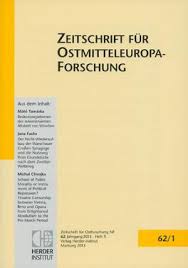Drei Predigten des Kardinals Odo von Châteauroux über Hedwig von Schlesien. Wandlungen und Kontinuitäten im Heiligenideal des 13. Jahrhunderts
Three sermons by the Cardinal Odo of Châteauroux on St. Hedwig of Silesia. Continuities and changes in the ideal of sainthood during the 13th century
Author(s): Otfried KrafftSubject(s): Christian Theology and Religion, 13th to 14th Centuries, History of Religion
Published by: Verlag Herder-Institut
Keywords: Three sermons; Cardinal Odo of Châteauroux; St. Hedwig of Silesia; Continuities and changes; ideal of sainthood; 13th century;
Summary/Abstract: Few contemporary sources on St. Hedwig of Silesia (t 1243) have survived. Il is only from the time after her canonization in 1267 that we have more texts on her biography. While the oldest surviving works of genuine hagiographic character were written around the year 1300 (Legenda maior and Legenda minor), the papal letter of canonization issued by Clement IV. was the earliest document to report on Hedwig as a saint. In this letter, the pope also mentioned a “relatio" held by Odo of Chäteauroux, cardinal bishop of Tusculum, to inform the consistory about Hedwig’s life and miracles. As research in this field has intensified, three sermons on this saint have been found in the vast collections of Odo’s works. These three discourses on Hedwig were obviously delivered in spring 1267, at the time when her canonization was prepared and finally celebrated. The first sermon was an exhortation to proceed to this canonization. The useful effects of a saint’s approbation by the Roman church were discussed in detail, while Hedwig’s individual traits were merely described in a vague manner. In his second sermon Odo identified Hedwig as a "mulierfords", giving several hints on her genealogy, her role as a virtuous wife and mother, and also as a generous donator to the Cistercian nunnery of Trebnitz (today’s Trzebnica), which was founded by her husband, the Piast Henry I. Aspects of her chastity and ascetic lifestyle played an important role in this sketch, while poverty as a virtue seemed to be of minor importance. Odo’s third sermon discussed some aspects of Hedwig as a blessed widow. Her positive influence on her descendants was described according to the concept of the “beata stirps”. Moreover, some particulars of her virtues and mortification were specified, thereby adding interesting details to the facts already known. In general, Odo evoked a special kind of conservative sainthood not altogether fitting into the then influential Franciscan model. This point also marked the distinction between Hedwig and her younger saintly relatives (e.g. Elizabeth of Thuringia. Margaret of Hungary or Anne, Hedwig's daughter-in-law). Odo's attitude was significant for the modified criteria to select saints, which were apparently in use after around 1260. These changes on the side of the papacy must be seen as preconditions for Hedwig’s successful canonization. Odo’s sermons confirm the general image given in the other sources on the saint. Some literal similarities lead to the conclusion that all these texts - in spite of their differing intentions and criteria of selection or stylization - refer to a common archetype, most probably the lost records or testimonies of the process of canonization. Nonetheless, Odo’s three sermons were not meant to give a complete picture of the saint but rather to stress certain aspects that seemed important to him. Even miracles connected to Hedwig were not thoroughly discussed by the preacher, though they were essential for a saint’s recognition. Anyway, as Odo’s three sermons belong to the oldest sources on St. Hedwig, they are crucial to the understanding of Silesia’s holy duchess.
Journal: Zeitschrift für Ostmitteleuropa-Forschung
- Issue Year: 55/2006
- Issue No: 4
- Page Range: 477-509
- Page Count: 33
- Language: German

